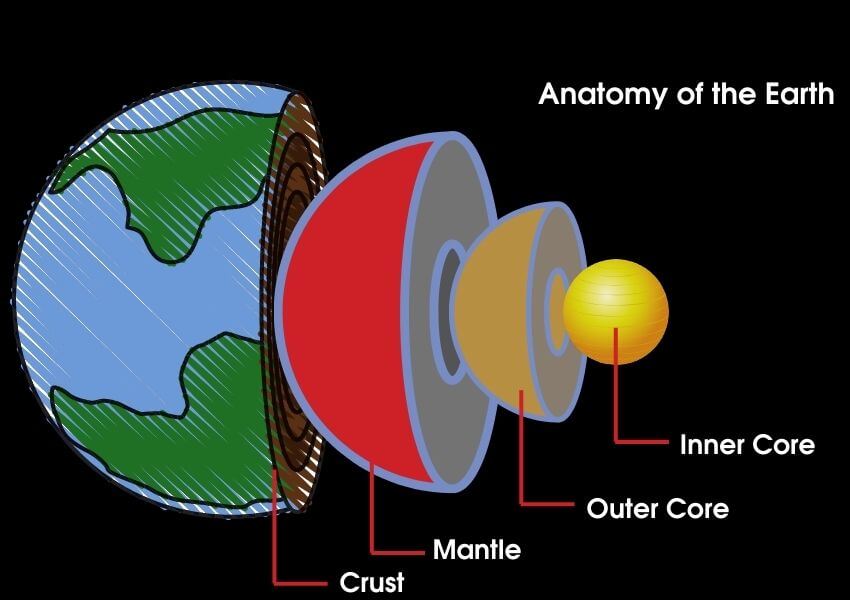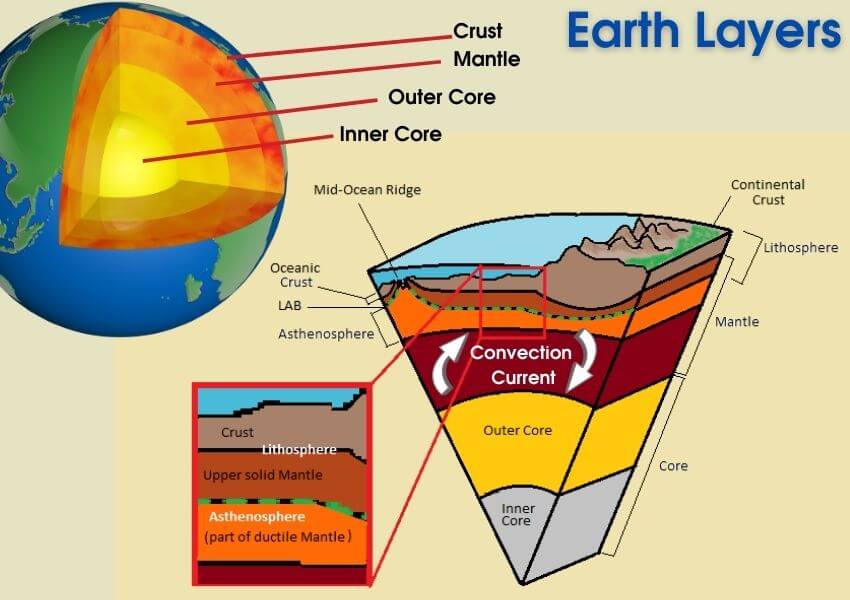Layers of the Earth
Today we will explore divers layers of the Earth: crust, mantle, and core. Let's begin to slop out all the layers of the Earth one away one.

The Earth is composed of four different layers:
- The crust (1 percent of Earth's volume)
- The mantle (84 percent)
- The musical outer core
- The solid-state inner core (combinedly 15 percent).
Earth's Crust
The Cheekiness is the Outer and THINNEST layer of the Worldly concern where we live. Earth's impertinence is about 19 miles (30 kilometer) deep on the average on land. At the bottom of the ocean, the incrustation is still about 3 miles (5 km) esoteric. (According to spaceplace.NASA.gov).
The crust of the Earth is composed of various chemical elements, minerals, or rock 'n' roll types.
The most joint natural science elements are oxygen, silicon, aluminum, iron, calcium, potassium, sodium, and magnesium.
The most common rocks are Igneous rocks (granite, basalt), Hemimetamorphous rocks (gneiss, amphibolite), Sedimentary rocks (sandstone, shale, limestone).
More than 90% of the crust is imperturbable of silicate minerals.
Related Article: Layers of the Atmospheric state
There are two types of crust: CONTINENTAL Impertinence and Oceanic Gall.
CONTINENTAL CRUST: The Terra firma's outer rocky bed, made up of rocks that belong primarily of silica and alumina known as the "sial".
OCEANIC CRUST: below the continental impertinence, composed of dense rocks, primarily the igneous rock basalt
The boundary between the crust and basic mantle is termed the Mohorovicic discontinuity, often referred to as the Moho .
Did You Know? The oldest rocks on our major planet are part of the continental crust and date vertebral column approximately 4 billion long time in age.
Earth's Mantle
The mantle is the LARGEST LAYER of the earth that lies beneath the crust. IT represents 84% of the Worldly concern's volume.
The mantle goes 1,800 miles (2,900 km) deep. This layer is composed of very passionate, dense rock, rich in the chemical elements magnesium, silicon, and oxygen.
In the speed mantle, temperatures range 'tween 500 to 900 °C (932 to 1,652 °F). In the lower curtain, temperatures lavatory reach over 4,000 °C (7,230 °F).

Tectonic Plates:
The tectonic plates are a combination of the crust and the upmost piece of the mantle, also named the LITHOSPHERE.
These plates have asymmetric shapes and fit together, just look-alike puzzle pieces.
Areas where the edges of plates touch each past, are called Photographic plate BOUNDARIES. Nigh natural events, including volcanoes, earthquakes, and mountain building, occur at plate boundaries.
The mantlepiece has an incredibly dense, hot, thick material that slowly circulates in giant CONVECTION CURRENTS, which drag the crust approximately.
Know More About: Plate Tectonics
Related Clause: The Piddle Cycle
What are convection currents::
Convection is a warmth transfer process. Convection currents transfer heat from one place to another away masses motion of a graceful or gas particles. Boiling water in a corporation is a good example of convection currents.
The boundary between the base of the chimneypiece and the outer Congress of Racial Equality is termed the GUTENBERG DISCONTINUITY.
Earth's Outer Core
The outer core is composed mostly of the fusible metals nickel and iron. It is close to 1400 miles (2253 km) thick, and its average temperature is 9,000 F (5,000 Anders Celsius).
It is the movement of the limpid within the outer core that generates Earth's magnetic field.
Earth's Inner Core
The inner core is an extremely hot ball of serious metallic-looking, poised mainly of iron and nickel.
While the inner core is hotter than the outmost core, still iron and nickel remain solid in this layer. It is solid because the inner marrow is under an incredible amount of pressure sensation (over 3 trillion times greater than happening Earth's surface) from the sleep of the layers on pass of it.
It is about 1,585 miles (2,550 km) across, and the temperature is about 10,800 F (6,000 C). The central sum is the hottest set out of the Worldly concern, as hot as the sun's surface.

In Summary - Layers of the Earth
1. The Encrustation
- It is the External bed and THINNEST portion of the Earth.
- It is made up of solid rocks and minerals.
- In that location are Cardinal types of crust: CONTINENTAL and OCEANIC crust.
- Limitless crust – Basalt
- Continental cheekiness – Granite
- Oceanic cheekiness is more heavy than continental incrustation.
- The boundary betwixt the crust and underlying mantle is termed the Mohorovicic discontinuity, often referred to A the Mohorovicic discontinuity.
3. The Outer Center
- IT is composed mostly of the melted metals nickel and iron.
- Movement of the dissolved within the outward core generates Earth's magnetic field
2. The Mantle
- It is the LARGEST level of the ground that lies beneath the impertinence.
- IT represents 84% of the Earth's volume
- This layer is unruffled of selfsame heatable, compact rock candy, and comfortable in the chemic elements.
- Peak portion of the mantle is named the ASTHENOSPHERE.
- Density increases with depth attributable accretive pressure.
- The boundary betwixt the substructure of the mantle and the outer core is termed the Gutenberg discontinuity.
4. The Internal Core
- Information technology is an passing hot ball of solid metal, cool mainly of iron and nickel.
- The inner core is the hottest part of the Worldly concern.
Layers of the Earth Ofttimes Asked Questions - FAQs
What is the out level of the Earth?
The Gall is the outer layer of the Earth.
What are the different layers of the Earth?
The different layers of the Earth are the crust, mantle, satellite core, and inner substance.
What are the two types of Crust?
Continental cheekiness and oceanic crust are the cardinal types of Earth's insolence.
What is the hottest stratum of the earthly concern?
The inner core is the hottest layer of the ground.
What is the largest bed of the earth?
The Mantle is the largest layer of the earth.
What is the thinnest layer of the earth?
Crust is the thinnest layer of the earth.
What are Tectonic Plates?
The tectonic plates are a combination of the Earth's crust and the uppermost partly of the mantle, also titled the lithosphere.
what part of earth is composed mainly of metals
Source: https://smartclass4kids.com/layers-of-the-earth/
Posting Komentar